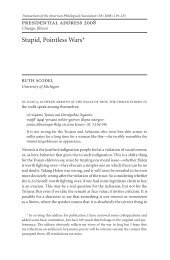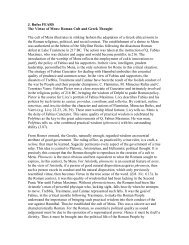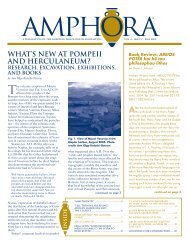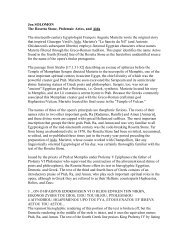classics rewritten in stone: the art of anita huffington - American ...
classics rewritten in stone: the art of anita huffington - American ...
classics rewritten in stone: the art of anita huffington - American ...
Create successful ePaper yourself
Turn your PDF publications into a flip-book with our unique Google optimized e-Paper software.
Ask A Classicist<br />
QWe had <strong>the</strong> opportunity to visit<br />
<strong>the</strong> A<strong>the</strong>nian Agora recently, and<br />
were surprised to see a church<br />
with<strong>in</strong> <strong>the</strong> conf<strong>in</strong>es <strong>of</strong> <strong>the</strong> site. What’s that<br />
about?<br />
AA visit to <strong>the</strong> A<strong>the</strong>nian Agora<br />
deserves to be p<strong>art</strong> <strong>of</strong> anyone’s<br />
pilgrimage to Greece. Ancient<br />
A<strong>the</strong>ns’ civic center – <strong>the</strong> site <strong>of</strong> government<br />
build<strong>in</strong>gs provid<strong>in</strong>g <strong>of</strong>fice space for <strong>of</strong>ficials,<br />
archives, law-courts, and meet<strong>in</strong>g<br />
rooms - was <strong>in</strong>tegral to <strong>the</strong> life <strong>of</strong> <strong>the</strong> city<br />
from <strong>the</strong> sixth century B.C. Visitors to <strong>the</strong><br />
modern site will f<strong>in</strong>d <strong>the</strong> elegant temple <strong>of</strong><br />
Hephaestus, what rema<strong>in</strong>s <strong>of</strong> <strong>the</strong> Pa<strong>in</strong>ted<br />
Stoa, <strong>the</strong> Bouleuterion (<strong>the</strong> meet<strong>in</strong>g house<br />
<strong>of</strong> <strong>the</strong> council), <strong>the</strong> Tholos (<strong>the</strong> d<strong>in</strong><strong>in</strong>g room<br />
for council members), and <strong>the</strong> elegantly<br />
reconstructed Stoa <strong>of</strong> Attalos, now <strong>the</strong><br />
Agora Museum. In <strong>the</strong> past, ancient festive<br />
processions followed <strong>the</strong> Pana<strong>the</strong>naic Way<br />
through <strong>the</strong> Agora from <strong>the</strong> Dipylon Gate to<br />
<strong>the</strong> Acropolis. The stoas <strong>of</strong> <strong>the</strong> Agora<br />
<strong>of</strong>fered classrooms and lecture space for<br />
philosophers and sophists throughout classical<br />
antiquity. It is difficult for a modern visitor<br />
to <strong>the</strong> Agora not to feel awed at <strong>the</strong><br />
thought <strong>of</strong> stand<strong>in</strong>g on a spot trodden so<br />
many centuries ago by <strong>in</strong>dividuals whose<br />
lives we care greatly about.<br />
Visitors enter <strong>the</strong> site from <strong>the</strong> Thiseio<br />
metro station and, after perus<strong>in</strong>g <strong>the</strong> museum<br />
collection <strong>in</strong> <strong>the</strong> Attalos Stoa, meander<br />
Fig. 4. Church <strong>of</strong> <strong>the</strong> Holy Apostles <strong>in</strong> <strong>the</strong> A<strong>the</strong>nian Agora.<br />
along <strong>the</strong> paths lead<strong>in</strong>g among <strong>the</strong><br />
monuments. As <strong>the</strong>y approach <strong>the</strong> southwest<br />
corner <strong>of</strong> <strong>the</strong> Agora, very near <strong>the</strong><br />
place where <strong>the</strong> classical M<strong>in</strong>t and <strong>the</strong><br />
imperial Roman Nymphaion had once<br />
been, <strong>the</strong>y will encounter Agioi Apostoli<br />
Solake, <strong>the</strong> Church <strong>of</strong> <strong>the</strong> Holy Apostles.<br />
Holy Apostles is a small but very<br />
impressive church. It shares with o<strong>the</strong>r small<br />
churches still <strong>in</strong>tact <strong>in</strong> A<strong>the</strong>ns a number <strong>of</strong><br />
architectural features. Like Kapnikarea, <strong>the</strong><br />
little church <strong>in</strong> <strong>the</strong> middle <strong>of</strong> <strong>the</strong> high-end<br />
shopp<strong>in</strong>g district on Hermou Street, Holy<br />
Apostles is an example <strong>of</strong> <strong>the</strong> cross-<strong>in</strong>square<br />
style, <strong>in</strong> which a central dome rises<br />
above four corner bays, which <strong>in</strong> turn are<br />
jo<strong>in</strong>ed by four lower gro<strong>in</strong>-vaulted bays.<br />
Characteristic <strong>of</strong> <strong>the</strong> Byzant<strong>in</strong>e churches at<br />
A<strong>the</strong>ns, Holy Apostles’ slender dome has<br />
eight small and narrow arches. One can<br />
see a very similar dome atop St. Joannes<br />
Theologos on <strong>the</strong> way up to visit <strong>the</strong> Acropolis,<br />
at <strong>the</strong> place where Erotokritou Street<br />
meets Erech<strong>the</strong>os.<br />
Holy Apostles does <strong>in</strong>deed seem out <strong>of</strong><br />
place at a site that showcases <strong>the</strong> rema<strong>in</strong>s<br />
<strong>of</strong> classical antiquity. Built dur<strong>in</strong>g <strong>the</strong><br />
eleventh century when A<strong>the</strong>ns was p<strong>art</strong> <strong>of</strong><br />
<strong>the</strong> Byzant<strong>in</strong>e Empire, not only is it by far<br />
<strong>the</strong> most recent <strong>of</strong> <strong>the</strong> Agora monuments,<br />
but it also shares with <strong>the</strong> temple <strong>of</strong> Hephaestus<br />
<strong>the</strong> dist<strong>in</strong>ction <strong>of</strong> be<strong>in</strong>g more or<br />
less <strong>in</strong> <strong>the</strong> state its orig<strong>in</strong>al builders <strong>in</strong>tended.<br />
This is not to say that it has not undergone<br />
changes over <strong>the</strong> centuries. Some <strong>of</strong><br />
<strong>the</strong>se changes were quite destructive: dur<strong>in</strong>g<br />
<strong>the</strong> seventeenth century, when <strong>the</strong> Venetians<br />
challenged<br />
<strong>the</strong> Ottoman presence<br />
<strong>in</strong> Greece,<br />
p<strong>art</strong> <strong>of</strong> <strong>the</strong> western<br />
end <strong>of</strong> Holy<br />
Apostles was seriously<br />
damaged<br />
by cannon fire.<br />
O<strong>the</strong>r changes<br />
enlarged and<br />
attempted to<br />
improve <strong>the</strong> little<br />
church: one <strong>of</strong> <strong>the</strong><br />
most extensive <strong>of</strong><br />
<strong>the</strong>se positive<br />
changes occurred<br />
<strong>in</strong> <strong>the</strong> latter half<br />
<strong>of</strong> <strong>the</strong> n<strong>in</strong>eteenth<br />
century. As A<strong>the</strong>ns grew more aware <strong>of</strong> its<br />
classical past and concerned about preserv<strong>in</strong>g<br />
its most ancient and beautiful antiquities,<br />
this n<strong>in</strong>eteenth-century addition was<br />
removed <strong>in</strong> 1954-6, when <strong>the</strong> church was<br />
carefully and lov<strong>in</strong>gly reconstructed with<br />
funds provided by <strong>the</strong> Samuel H. Kress<br />
Foundation.<br />
Holy Apostles is a monument to <strong>the</strong><br />
perenniality <strong>of</strong> A<strong>the</strong>ns. This extraord<strong>in</strong>ary<br />
city has been <strong>in</strong>habited for millennia:<br />
archaeologists, who with great care pry out<br />
<strong>the</strong> <strong>in</strong>dividual levels <strong>of</strong> its habitation, can<br />
trace its earliest dwellers to <strong>the</strong> Neolithic<br />
Period <strong>in</strong> <strong>the</strong> fifth millennium. Accord<strong>in</strong>g to<br />
<strong>the</strong> <strong>American</strong> School <strong>of</strong> Classical Studies at<br />
A<strong>the</strong>ns, primary excavator <strong>of</strong> <strong>the</strong> Agora,<br />
<strong>the</strong> use <strong>of</strong> <strong>the</strong> place as a city-center doesn’t<br />
beg<strong>in</strong> until <strong>the</strong> time <strong>of</strong> <strong>the</strong> rule <strong>of</strong> <strong>the</strong> Pisistratids<br />
<strong>in</strong> <strong>the</strong> mid-sixth century B.C., just<br />
decades before <strong>the</strong> establishment <strong>of</strong> <strong>the</strong><br />
democracy. Holy Apostles is a youthful<br />
build<strong>in</strong>g when looked at <strong>in</strong> <strong>the</strong>se terms. The<br />
little church was created at <strong>the</strong> beg<strong>in</strong>n<strong>in</strong>g <strong>of</strong><br />
a period <strong>of</strong> prosperity for <strong>the</strong> Byzant<strong>in</strong>e<br />
city. It knew <strong>the</strong> Archbishop <strong>of</strong> A<strong>the</strong>ns,<br />
Michael Akom<strong>in</strong>ates, before his exile at <strong>the</strong><br />
com<strong>in</strong>g <strong>of</strong> <strong>the</strong> Western Europeans <strong>in</strong> 1204.<br />
The church watched <strong>the</strong> <strong>in</strong>stallation <strong>of</strong><br />
French rul<strong>in</strong>g families <strong>in</strong> 1204, <strong>the</strong>n <strong>the</strong><br />
com<strong>in</strong>g <strong>of</strong> <strong>the</strong> Catalan conquistadores <strong>in</strong><br />
1311, followed by Florent<strong>in</strong>e and Venetian<br />
dukes <strong>in</strong> 1388. It saw <strong>the</strong> <strong>in</strong>ception <strong>of</strong> <strong>the</strong><br />
Turkocratia <strong>in</strong> Greece <strong>in</strong> 1456, when<br />
A<strong>the</strong>ns devolved <strong>in</strong>to a village under <strong>the</strong><br />
dom<strong>in</strong>ion <strong>of</strong> <strong>the</strong> Ottoman Turkish sultan at<br />
Constant<strong>in</strong>ople. And it celebrated A<strong>the</strong>ns’<br />
new status as capital <strong>of</strong> <strong>in</strong>dependent<br />
Greece <strong>in</strong> <strong>the</strong> year 1834. Now <strong>in</strong> 2010,<br />
sport<strong>in</strong>g its newly reconstructed form, with<br />
refreshed old icons and dome-tiles<br />
replaced, it cont<strong>in</strong>ues to welcome <strong>in</strong>ternational<br />
visitors com<strong>in</strong>g to enjoy <strong>the</strong> antiquity<br />
<strong>of</strong> <strong>the</strong> A<strong>the</strong>nian Agora.<br />
Fur<strong>the</strong>r <strong>in</strong>formation on, pictures <strong>of</strong>, and<br />
suggestions for fur<strong>the</strong>r read<strong>in</strong>g about <strong>the</strong><br />
Church <strong>of</strong> <strong>the</strong> Holy Apostles can be found<br />
at http://www.attalos.com/guide<br />
/Introduction.html, an excellent site ma<strong>in</strong>ta<strong>in</strong>ed<br />
by <strong>the</strong> A<strong>the</strong>nian School <strong>of</strong> Classical<br />
Studies at A<strong>the</strong>ns. For an <strong>in</strong>-depth and<br />
<strong>in</strong>formative discussion <strong>of</strong> some <strong>of</strong> <strong>the</strong> great<br />
churches not only <strong>of</strong> A<strong>the</strong>ns but many o<strong>the</strong>r<br />
places around <strong>the</strong> world, see<br />
http://www.sacred-dest<strong>in</strong>ations.com/.<br />
5



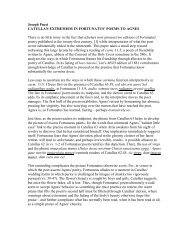
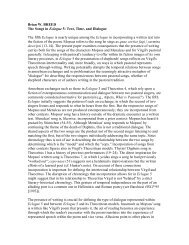
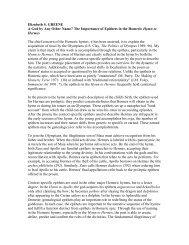


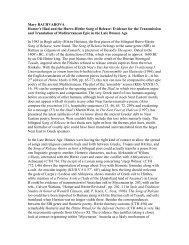

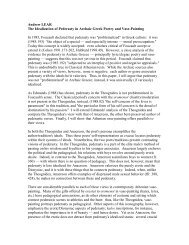
![John H. STARKS, Jr. [vo]cales vultus:Pantomime Actresses in Latin ...](https://img.yumpu.com/11930335/1/190x245/john-h-starks-jr-vocales-vultuspantomime-actresses-in-latin-.jpg?quality=85)
